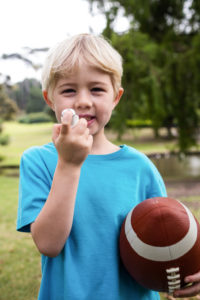What is Dry Drowning?
The recent tragedy of a 4 year old Texas child has focused many parents on the issue of “dry drowning.” The heartbreaking story of the victim has not only generated sympathy around the country, but also fear in many parents’ minds about this unfamiliar danger to their own children. How much of a danger does “dry drowning” pose, what exactly is it, and what can you do to recognize it and protect your children?
First, it is very important to keep the risk in perspective: these events are very rare. In fact, Cook’s Children’s Hospital in Texas, one of the 12 largest children’s hospitals in the United States, has treated only one case of “dry drowning” in nine years!
Having said that, there are actually two separate and distinct types of events, true “dry drowning” and “secondary drowning”, that get lumped together by the lay press as “dry drowning.” It’s an easy mistake to make because both occur while the child is no longer in the water and have similar symptoms.
True “dry drowning” occurs when inhalation of water into the upper airway results in an excessive instinctive response that closes off the airway at the level of the vocal cords (called “laryngospasm”). While this keeps water from getting into the lungs, it also prevents air and oxygen from getting there as well. Episodes of true “dry drowning” tend to occur almost immediately with the child choking, sputtering and gagging within minutes of inhaling the water.
On the other hand, in “secondary drowning” some fluid actually gets into the lungs, but not enough to immediately overwhelm the child’s breathing. Typically the child has an episode of coughing/sputtering but seems to recover at the scene. Symptoms then begin to re-emerge anywhere from an hour to 24 hours later. Although, very rarely, this can occur as much as a week later. The water in the lungs causes inflammation and respiratory compromise and is often mistaken for an oncoming viral illness until the child is in severe distress.
How to Recognize Dry Drowning and Secondary Drowning
While reiterating that these are rare occurrences, it’s still wise to know how to recognize if/when this is happening. What can you do to prevent this from happening to your child? Supervision, Supervision, Supervision…..and knowing the symptoms to look out for.
The symptoms of both of these entities include:
- Persistent Coughing/Chest Pain
- Difficulty/Labored breathing
- Sudden severe sleepiness/fatigue
- Sudden irritability/changes in mental status
- Vomiting
Should these symptoms occur, take your child to the Emergency Department immediately.
Finally, with all the publicity surrounding these unusual events, it is important to note that the more typical “wet drowning” is by far the greater risk. Please remember that drowning is a silent killer. Victims rarely thrash or scream—they’re too busy gasping for air to make a lot of noise. Signs to watch for include:
- Head/mouth bobbing above and below water level
- Head tilted back
- Wall-clinging (crawling along the wall because the child is too tired)
- Arms moving downward (“climbing an invisible ladder”)
It’s hard to find the right balance of vigilance vs. paranoia, but hopefully, this information will help you enjoy the water with your children safely and happily all summer!






 This Valentine’s Day, indulge your little sweethearts without causing/contributing to massive sugar overload by trying out some or all of the following tips.
This Valentine’s Day, indulge your little sweethearts without causing/contributing to massive sugar overload by trying out some or all of the following tips. Even though it is winter, children need to get out, play, and participate in sports. We often see children who are having symptoms of exercise induced asthma during the winter because the cold and the exercise can both be triggers. Children with asthma should be able to fully participate in the sport of their choice without asthma exacerbations or other symptoms of their asthma impacting their endurance or performance. If you feel like your child is not able to keep up with their peers, it might be time for an asthma tune up. Or if you are concerned that your child might have exercise induced asthma (EIA), it might be time to have them evaluated. Sometimes it is hard to tell the difference between your child not being in shape and becoming short of breath and exercise induced asthma.
Even though it is winter, children need to get out, play, and participate in sports. We often see children who are having symptoms of exercise induced asthma during the winter because the cold and the exercise can both be triggers. Children with asthma should be able to fully participate in the sport of their choice without asthma exacerbations or other symptoms of their asthma impacting their endurance or performance. If you feel like your child is not able to keep up with their peers, it might be time for an asthma tune up. Or if you are concerned that your child might have exercise induced asthma (EIA), it might be time to have them evaluated. Sometimes it is hard to tell the difference between your child not being in shape and becoming short of breath and exercise induced asthma.
 With the New Year many of our families will see their deductibles reset – just in time for flu season!
With the New Year many of our families will see their deductibles reset – just in time for flu season!